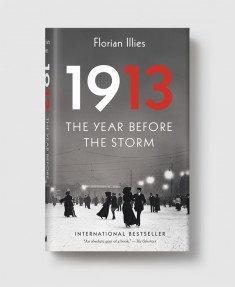October 1, 2013
This week in 1913
by Melville House
From now until the end of the year, we’ll be publishing weekly excerpts from 1913, which The Observer called “An absolute gem of a book.”1913 was the year Henry Ford first put a conveyer belt in his car factory, and the year Louis Armstrong first picked up a trumpet. It was the year Charlie Chaplin signed his first movie contract, and Coco Chanel and Prada opened their first dress shops. It was the year Proust began his opus, Stravinsky wrote The Rite of Spring, and the first Armory Show in New York introduced the world to Picasso and the world of abstract art. It was the year the recreational drug now known as ecstasy was invented.
Date unknown [the Wednesday of this week would have been today]:
Ludwig Meidner’s apocalyptic landscapes: “In Ludwig Meidner’s studio at 21 Wilhelmshöher Strasse in Berlin-Friedenau an illustrious circle gathers every Wednesday evening… First, the master of the house shows the guests his latest works. He calls them ‘Apocalyptic Landsacpes.’ They are in keeping with his motto: ‘Paint your grief, your entire insanity and sanctity out of the whole of your being.’ In Meidner’s landscapes everything is exploding”
Oct. 5:
Rilke unimpressed by theatergoers: “On 5 October 1913, Paul Claudel’s play L’Annonce faite à Marie is performed in Dresden-Hellerau. Lured by the reformist zeal of the Hellerau Dance School, the Dalcroze Method and Heinrich Tessenow’s new Festival Hall, the audience is extremely select… Upton Sinclair, the American author, who was probably in Hellerau on 5 October too, later wrote in his novel World’s End: ‘At Hellerau they taught you an alphabet and a grammar of movement. With your arms you kept the time; a set of movements for three-part time, another for four, and so on. With your feet and body you indicated the duration of notes. It was a kind of rhythmic gymnastics, planned to train the body in quick and exact response to mental impressions.’
“… That night Claudel made a confused note in his journal about the almost complete absence of applause. Dalcroze even referred to it publicly as a fiasco. Rilke summed up the evening and its irritations beautifully in his letters to Hugo von Hofmannsthal and Helene von Nostitz: ‘Like overgrown children, the people of Hellerau are getting involved in something they don’t understand’.”
Date unknown:
Kirchner paints one of the “unique pictures of a modern age: “Ernst Ludwig Kirchner … returns to Berlin from Fehmarn at the end of September, happy and laden down with paintings…. He and Erna Schilling hunt for a new den together, and find one at 45 Körnerstrasse. They are back in Berlin, that ‘tastelessly muddled and rather senselessly unfurling city,’ as Rilke so eloquently described it at the time…. He begins with Berlin Street Scene, the first picture from his ‘Potsdamer Platz’ series…. Kirschner succeeds in creating unique pictures of a modern age in which the bodies of the city consist no longer of flesh and blood, but only of longing and nerves.”
